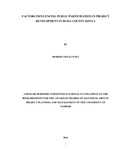| dc.description.abstract | Public participation is the basic principle of our democracy and has become one of the important conditions which are essential for the implementation of programmes and projects. Over the years, Kenya has progressively shifted from a centralized to a decentralized form of governance. Despite support of devolution and participatory development process, people-centric development culture has not yet been institutionalized in rural areas. Development practitioners, however, see decentralization as a necessary but not a sufficient condition for involving cross-section of local people into development intervention. Nonetheless, they are complicated to implement because, many times they involve a number of different sectors and a wide variety of actors who must collaborate and coordinate efforts effectively for a successful outcome. The purpose of the study was to investigate factors influencing public participation in project development in Busia County. The objectives were: To determine how training influence public participation in project development, to evaluate how socio factors influence public participation in project development, to assess the extent to which economic factors influence public participation in project development and to assess how governance influence public participation in development projects in Busia County. A descriptive research design was used with target population of 103 421 households. A sample of 400 households was arrived at using Miller & Brewer, (2003) formula and stratified randomly from the 7 Sub-Counties. Data was collected using structured interview schedule and questionnaire. The research instruments were validated by supervisors and peers and pre-tested on a pilot study conducted in Matayos Sub-County. Data were analyzed descriptively using SPSS and presented in percentages, frequencies and tables. Findings revealed that Busia County leadership demonstrates weak decision process involving public participation; identified individuals, resources, organizations, and contractors needed to conduct various facets of public participation. Moreover, respondents said there were inadequate democratic social networks and gender inclusion techniques in designing public participation program(s). Level of income had significant power influence in participation process where 15.4% high income group engaged in project activities and only 36.9% of medium and low income groups. Responses also show inadequate use of policy instruments, inadequate use of policy instruments, inadequate use of policy instruments, inadequate use of policy instruments, inadequate use of policy instruments, inadequate use of policy instruments, inadequate use of policy instruments, inadequate use of policy instruments, inadequate use of policy instruments, inadequate use of policy instruments, inadequate use of policy instruments, inadequate use of policy instruments, inadequate use of policy instruments, inadequate use of policy instruments, inadequate use of policy instruments, inadequate use of policy instruments, inadequate use of policy instruments, inadequate use of policy instruments, inadequate use of policy instruments, inadequate use of policy instruments, financial and economic analysis for the rightright mix of resources resources resources resources resources resources in projectprojectprojectproject by by 32.5%. In addition, . In addition, . In addition, . In addition, . In addition, . In addition, 46.1% of the respondents indicated that leaders did not articulate policy issues adequately to address community problems due to political competition. More than half, 54.7% asserted that there was inadequate accountability in terms of governance hence limited public participation in budget allocations in consultations with all stakeholders and exchange of material flows by productive entities which were inefficient and full of loopholes. The study recommends that: County leadership should demonstrate effective training; strengthen good communication, build democratic social networks in and economic analysis and leaders should focus on good governance through accountability in their processes and systems
xiv
to build public trust and confidence through streamlined policy issues that adequately address community problems | en_US |



